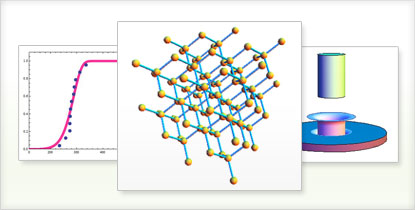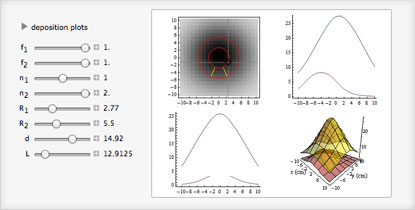The Wolfram Solution forMaterials ScienceModel new materials using powerful symbolic and numeric computational abilities, visualize crystal structures interactively, and measure performance by analyzing deformation and failure data with sophisticated statistics—all in one integrated workflow. Underlying the Wolfram materials science solution is the most automated and reliable computation, development, and deployment environment available. |
 |
Wolfram technologies include thousands of built-in functions and curated data on many topics that let you:
- Calculate the expected stresses and strains on material as it is deformed and analyze deformation data to determine its stiffness and strength
- Post-process derived equations to convert them to code that will control machining equipment
- Instantly create interactive tools for data analysis, presentation, or sharing ideas with colleagues and deploy them to others with Wolfram CDF Player
- Solve complex analytic geometry problems to design new structures
- Model and analyze future measurement or manufacturing equipment for semiconductor production
- Design, test, and manufacture lightweight and strong materials
- Study the effects of different processing techniques on material properties
- Apply computational quantum mechanics to design new materials
- Work with built-in lattice and polyhedron data, plus materials properties and other data from Wolfram|Alpha
- Perform reliability analysis to improve system reliability

Analyze test data, visualize molecular structures, and model manufacturing methods

Create visualizations for lectures and presentations
Does your current tool set have these advantages?
-
Symbolic calculations improve the accuracy and flexibility of structural or performance models
Matlab's built-in routines only handle numeric calculations -
Gain accuracy in predicting behavior at small length scales with built-in, fully automated precision control and arbitrary-precision arithmetic
Excel, Matlab, and other systems relying on machine arithmetic can show critical errors due to numerical accuracy failure -
Choose from procedural, functional, and rule-based programming paradigms for fast development of analysis tools or theoretical models
Mathcad only has a simple procedural programming language built in -
Import, compute, and deliver results in one interactive document instead of across several applications
Matlab does not have a built-in document system

Design and test new materials or processing techniques

Instantly create interactive tools for data analysis, presentation, or sharing ideas with colleagues
Materials science specific capabilities:
- Solve differential equations with discontinuities, hybrid discrete/continuous dynamical systems, and differential algebraic equations to model and design new materials with specified properties or structures »
- Create reusable models of material performance or processing methods with symbolic computations; use numerical computations when equations can't be solved symbolically
- Built-in statistical analysis, curve-fitting functions, and probability distributions for data analysis »
- Functions for automatically computing probabilities and expectations of any event, for any uni- or multivariate distribution, allowing quick calculations for many problems
- Complete functionality for reliability analysis, including importance measures for pinpointing subsystems that help improve system reliability »
- Built-in calculus abilities for computing complicated integrals to determine properties of materials at boundaries »
- Built-in image processing functions, including automatic detection of image features and highly optimized linear and nonlinear image filters, to identify deformation or defects with microscopy »
- Linear and nonlinear optimization abilities, including the interior-point method, constrained nonlinear optimization, and more to optimize the structure of new materials »
- Highly customized, presentation-quality interactive graphics, with a large variety of powerful visualization functions »
- Build interactive tools for optimizing models by instantly viewing the effects of changing parameters »
- Built-in support for more than 4,500 units—including free-form linguistic entry, conversions, and dimensional consistency checking across graphics and numeric and symbolic calculations »
- Access curated physical, chemical, and other data from Wolfram|Alpha, immediately ready for analysis, interactively or programmatically »
- Import and export of common scientific data formats, including HDF5, GraphML, GXL, MTX, PDB, MOL, SDF, TSV, and CSV »
- Easy programmability lets you automate data analysis to speed characterization of new materials or convert formulas to code that controls manufacturing equipment »
- Built-in connectivity to databases, web services, existing C++ code, other commercial programs, and Java and .NET frameworks »




















